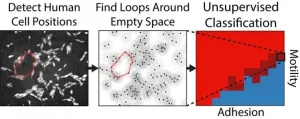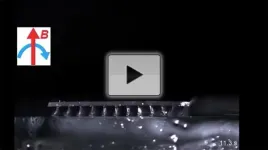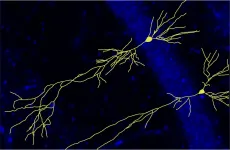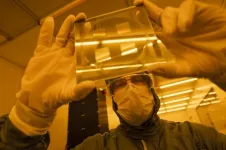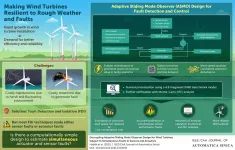(Press-News.org) PROVIDENCE, R.I. [Brown University] -- The field of mathematical topology is often described in terms of donuts and pretzels.
To most of us, the two differ in the way they taste or in their compatibility with morning coffee. But to a topologist, the only difference between the two is that one has a single hole and the other has three. There's no way to stretch or contort a donut to make it look like a pretzel -- at least not without ripping it or pasting different parts together, both of which are verboten in topology. The different number of holes make two shapes that are fundamentally, inexorably different.
In recent years, researchers have drawn on mathematical topology to help explain a range of phenomena like phase transitions in matter, aspects of Earth's climate and even how zebrafish form their iconic stripes. Now, a Brown University research team is working to use topology in yet another realm: training computers to classify how human cells organize into tissue-like architectures.
In a study published in the May 7 issue of the journal Soft Matter, the researchers demonstrate a machine learning technique that measures the topological traits of cell clusters. They showed that the system can accurately categorize cell clusters and infer the motility and adhesion of the cells that comprise them.
"You can think of this as topology-informed machine learning," said Dhananjay Bhaskar, a recent Ph.D. graduate who led the work. "The hope is that this can help us to avoid some of the pitfalls that affect the accuracy of machine learning algorithms."
Bhaskar developed the algorithm with Ian Y. Wong, an assistant professor in Brown's School of Engineering, and William Zhang, a Brown undergraduate.
There's been a significant amount of work in recent years to use artificial intelligence as a means of analyzing big data with spatial information, such as medical imaging of patient tissues. Progress has been made in training these systems to classify accurately, "but how they work is opaque and a little finicky," Wong said. "Just like people, sometimes computers hallucinate. You can have a few pixels in the wrong place, and it can confuse the algorithm. So Dhananjay has been thinking about ways we might be able to make those analyses a little more robust."
In developing this new system, Bhaskar took inspiration from modern art, specifically Pablo Picasso's "Bull." The series of 11 lithographs starts with a bull depicted in full detail. Each successive frame strips away a bit of detail, ending in a simple drawing capturing only the animal's fundamental attributes. By employing topology, Bhaskar thought he might be able to do something similar to understand the underlying form of tissue-like architectures.
The way in which cells migrate and interact depends on the physiology of the cells involved. For example, healthy tissues contain higher numbers of stationary epithelial cells. Processes like wound repair or cancer, however, often involve more mobile mesenchymal cells. Differences in physiology between the two cell types cause them to cluster together differently. Epithelial cells tend to aggregate into larger, more closely packed clusters. Mesenchymal cells tend to be more dispersed, with groups of cells branching off in different directions. But when assemblages contain a mix of both kinds of cells, it can be difficult to accurately analyze them.
The new algorithm uses a mathematical framework called persistent homology to examine microscope images of cell assemblages. Specifically, it looks at the topological patterns -- loops or holes -- that the cells form collectively. By looking at which patterns persist across different spatial resolutions, the algorithm determines which patterns are intrinsic to the image.
It starts by looking at the cells in their finest detail, determining which cells seem to be part of topological loops. Then it blurs the detail a bit by drawing a circle around each cell -- effectively making each cell a little larger -- to see which loops persist at that more coarse-grained scale and which get blurred out. The process is repeated until all the topological features eventually disappear. At the end, the algorithm produces a sort of bar code showing which loops persist across spatial scales. Those that are most persistent are stored as a simplified representation of the overall shape.
As it turns out, those persistent topological objects can be used to categorize clusters of differing types of cells. After training their algorithm on computer-simulated cells programmed to behave like different types of cells, the team turned it loose on real experimental images of migratory cells. Those cells had been exposed to varying biochemical treatments so that some were more epithelial, some were more mesenchymal, and some were somewhere in between. The study showed that the topological algorithm was able to correctly classify different spatial patterns according to which biochemical treatment the cells had received.
"It was able to pull out all of these experimental treatments just by identifying these persistent topological loops," Wong said. "We were kind of amazed at how well it did."
The team hopes that one day the algorithm could be used in laboratory experiments to test drugs, helping to determine how different drugs can alter cell migration and adhesion. Eventually, it may also be used on medical images of tumors, potentially helping doctors to determine how malignant those tumors may be.
"We're looking for ways to catch subtleties that might not be apparent to the human eye," Wong said. "We hope that this might be a human interpretable approach that complements existing machine learning approaches."
INFORMATION:
The research was supported by National Cancer Institute's Innovative Molecular Analysis Technologies Program (R21CA212932) and the Brown University Data Science Initiative.
One-quarter to one-third of young, active patients who undergo anterior cruciate ligament reconstruction experience a second ACL injury after they return to sport (RTS). New research indicates that young athletes who feel confident about their knee health at the time of medical clearance for sports participation after ACL surgery have a higher likelihood of meeting all RTS criteria related to physical function but also have a higher likelihood of experiencing a second ACL injury within 2 years after RTS.
The study, which included 159 participants with an average age of 17 years, is published in the Journal of Orthopaedic Research.
"These data suggest that as health care providers, we may need to re-evaluate the tools we currently use to determine readiness to return ...
The rhythmic motions of hair-like cilia move liquids around cells or propel the cells themselves. In nature, cilia flap independently, and mimicking these movements with artificial materials requires complex mechanisms. Now, researchers reporting in ACS Applied Materials & Interfaces have made artificial cilia that move in a wave-like fashion when a rotating magnetic field is applied, making them suitable for versatile, climbing soft robots and microfluidic devices. Watch a video of the artificial cilia here.
Replicating movements found in nature -- for example, the small, whip-like movements of cilia -- could ...
While the APP protein is well-known for its key role in Alzheimer's disease, its contribution to healthy brain function, by contrast, has remained largely unknown until now. Recently, an international research team, led by molecular biologist Prof. Dr Ulrike Müller from Heidelberg University, gained new insights on the physiological functions of the APP protein family by using a mouse model lacking APP. The absence of APP during brain development was shown to result in the malformation of important brain regions implicated in learning and memory. Consequently, these mice were severely impaired in their learning abilities and exhibited autistic-like ...
In an article published in the International Journal of Mental Health Nursing, experts stress that the COVID-19 pandemic presents the "perfect storm" for family violence, where a set of rare circumstances have combined to aggravate intimate partner violence, domestic abuse, domestic violence, and child abuse.
Factors during the pandemic that have come together to contribute to family violence may include increased stress and trauma, economic hardship, imposed isolation, and decreased access to community and faith-based support.
The authors note that public health officials and mental health professionals need to be aware of the impact of disasters on family violence, and they should strive to identify those at risk and provide ...
Individuals are often prescribed increasing numbers of medications as they age, and while many of these prescriptions are justifiable, some may be inappropriate. A recent analysis published in the British Journal of Clinical Pharmacology examined the results of all studies investigating associations between potentially inappropriate prescribing--which includes prescribing medications that may not produce benefits relative to harm and not prescribing medications that are recommended--and outcomes of older adults.
Potentially inappropriate prescribing was significantly associated with a range of health-related and system-related outcomes, including functional decline, falls, ...
By the end of the first year of the pandemic in metropolitan Stockholm, investigators estimate that one-fifth of adults in the region previously had COVID-19. The findings, which are published in the Journal of Internal Medicine, come from analyses of anti-viral antibody responses in healthy blood donors and pregnant women.
For the study, researchers examined blood from 2,600 blood donors and 2,500 pregnant women taken between March 14th 2020 and February 28th 2021. Blood donors and pregnant women had a similar rate of past infection, approaching 19% of the study group by the end of February 2021, shortly ...
Monash University researchers have engineered new antimicrobial surfaces that can significantly reduce the formation of bacteria on medical instruments, such as urinary catheters, and reduce the risk of patient infection while in hospital.
This world-first study demonstrates the potential for 3D engineered surfaces in preventing the initial formation of microcolonies of Escherichiacoli (E.coli), Klebsiellapneumoniae and Pseudomonas aeruginosa - the three most common urinary tract bacterial infections (UTIs) associated with catheters.
The study team, led by Dr Victor Cadarso, from Monash University's Department of Mechanical and Aerospace Engineering and the ...
SALT LAKE CITY - A new study published in the Journal of Clinical Oncology reports findings on Huntsman at Home™, a cancer hospital-at-home model operated by Huntsman Cancer Institute (HCI) at the University of Utah (U of U). The study analyzed aspects of Huntsman at Home acute care--meaning a level of care that is generally provided in an inpatient hospital setting.
In the 30 days after study entry, Huntsman at Home participants had 55% fewer hospitalizations, 45% fewer emergency department visits, and shorter hospital stays by one day. They also had 47% lower health care costs during the same 30-day period ...
A key driver of energy research is the ever-growing demand for energy. Traditional fossil-fuel-based energy sources currently meet these demands and do it well, but they're non-renewable and cause major environmental pollution. In a world with looming climate and resource crises threats, researchers have turned to renewable sources of energy as sustainable alternatives. Among renewables, wind energy, in particular, has gained considerable attention due to its low cost. As Dr. Afef Fekih, Computer Engineer at the University of Louisiana, USA, with a specialization in wind turbine design, notes, "Wind energy has been described as 'the world's fastest-growing renewable energy source', seeing a 30% annual growth on ...
A new survey study suggests that, for adolescents who received unplanned distance education due to the COVID-19 pandemic, experiencing one's own competence was linked to positive emotion, self-motivation to learn, and pro-learning behaviors. Feeling connected to others was also linked to positive emotion. Julia Holzer of the University of Vienna, Austria, and colleagues present these findings in the open-access journal PLOS ONE.
The new research draws on a psychological theory known as self-determination theory, which outlines three basic psychological needs for well-being: autonomy, connection to others, and experiencing one's own competence. Previous research has provided much ...
